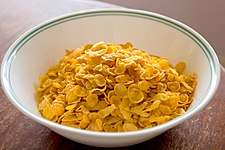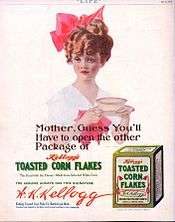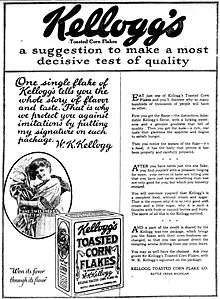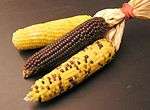Corn flakes
Corn flakes, or cornflakes, is a breakfast cereal made by toasting flakes of corn (maize). The cereal was created by William Kellogg in 1894 for his brother John Kellogg. John Kellogg wanted a food that would be healthy for the patients of the Battle Creek Sanitarium in Michigan where he was superintendent. The breakfast cereal proved popular among the patients, but Will Kellogg wanted to add sugar to increase the popularity. John Kellogg did not approve of this, so Will Kellogg started his own company Kellogg Company to produce corn flakes for the wider public. A patent for the process was granted in 1896, after a legal battle between the two brothers.
 Corn flakes | |
| Place of origin | United States |
|---|---|
| Region or state | Battle Creek Sanitarium in Michigan |
| Created by | John Harvey Kellogg (1894) W.K. Kellogg |
| Main ingredients | Milled corn, sugar, malt flavoring |
| Variations | multiple |
With corn flakes becoming popular in the wider community, a previous patient at the sanitarium, C. W. Post, started to make rival products. Kellogg continued to experiment and various ingredients were added and different grains were used. In 1928, he started to manufacture Rice Krispies, another successful breakfast cereal.
There are many generic brands of corn flakes produced by various manufacturers. As well as being used as a breakfast cereal, the crushed flakes can be a substitute for bread crumbs in recipes and can be incorporated into many cooked dishes.
Description
Corn flakes are a packaged cereal product formed from small toasted flakes of corn, usually served cold with milk and sometimes sugar. Since their original production, the plain flakes have been flavoured with salt, sugar, and malt, and many successive products with additional ingredients have been manufactured such as sugar frosted flakes and honey & nut corn flakes.[1] Corn flakes are produced in significant quantities at the Trafford Park factory in Manchester, England, which is the largest cereal factory in the world.[2]
History

The story of corn flakes goes back to the late 19th century, when a team of Seventh-day Adventists began to develop new foods to adhere to the vegetarian diet recommended by the church. Members of the group experimented with a number of different grains, including wheat, oats, rice, barley and maize. In 1894, John Harvey Kellogg, the superintendent of the Battle Creek Sanitarium in Michigan and an Adventist, used these recipes as part of a strict vegetarian regimen for his patients, which also included no alcohol, tobacco or caffeine. The diet he imposed consisted entirely of bland foods. A follower of Sylvester Graham, the man cited as inspiration of graham crackers and graham bread, Kellogg believed that spicy or sweet foods would increase passions.[3].
This idea for corn flakes began by accident when Kellogg and his younger brother, Will Keith Kellogg, left some cooked wheat to sit while they attended to some pressing matters at the sanitarium. When they returned, they found that the wheat had gone stale, but being on a strict budget, they decided to continue to process it by forcing it through rollers, hoping to obtain long sheets of the dough. To their surprise, what they found instead were flakes, which they toasted and served to their patients. This event occurred on August 8, 1894, and a patent for "Flaked Cereals and Process of Preparing Same" was filed on May 31, 1895, and issued on April 14, 1896.[4][5][6]

Dr. Kellogg introduced Kellogg's Corn Flakes in hopes that it would reduce dyspepsia and, in accordance with the practices of the Seventh-day Adventists, masturbation and excessive sexual intercourse.[7][8][9]
The flakes of grain, which the Kellogg brothers called granose, were a very popular food among the patients. The brothers then experimented with other flakes from other grains. In 1906, Will Keith Kellogg, who served as the business manager of the sanitarium, decided to try to mass-market the new food. At his new company, Battle Creek Toasted Corn Flake Company, he added sugar to the flakes to make them more palatable to a mass audience, but this caused a rift between his brother and him. In 1907, his same company ran an ad campaign which offered a free box of cereal to any woman who winked at her grocer.[10] To increase sales, in 1909 he added a special offer, the Funny Jungleland Moving Pictures Booklet, which was made available to anyone who bought two boxes of the cereal. This same premium was offered for 22 years. At the same time, Kellogg also began experimenting with new grain cereals to expand his product line. Rice Krispies, his next great hit, first went on sale in 1928.[11]
There have been many mascots of Kellogg's Cornflakes. The most popular one is a green rooster named Cornelius "Corny" Rooster, which has been the mascot since his debut. In early commercials, he would speak the catchphrase "Wake up, up, up to Kellogg's Cornflakes!" Dallas McKennon and Andy Devine voiced him. Later, he stopped talking and simply crowed. The concept of using a stylized rooster originated from a suggestion by family friend Nansi Richards, a harpist from Wales and a Welsh language proponent. The Welsh word for "rooster" is ceiliog (pronounced kayleeog or in some dialects kaylog), sounding similar to Kellogg's name.[12][13]
In cooking
There are a wide variety of different recipes for dishes involving corn flakes and crushed corn flakes can even be a substitute for bread crumbs.
Honey joys are a popular party snack in Australia. They are made by mixing corn flakes with honey, butter and sugar and baking in patty cases or muffin cups.[14] A variant popular in the UK is chocolate corn flake cakes, made with corn flakes, dark chocolate, golden syrup and butter.[15] In New Zealand, corn flakes are a core ingredient in Afghan biscuits, a chocolate biscuit made with corn flakes and topped with chocolate icing.[16]
Images
- Corn flakes are usually served with cold milk (but sometimes with warm or hot). Fruit is a popular addition. Sugar may be added to taste.
- Flaked corn is sweetened, flavored with peanut butter, and covered in compound chocolate to create the Butterfinger candy bar (and its imitations).

show as 360° surround photography
See also
- Genetically modified maize
- List of maize dishes
- Feuilletine
References
- Robert B. Fast; Elwood F. Caldwell (2000). Breakfast Cereals, and how They are Made. American Association of Cereal Chemists. ISBN 978-1-891127-15-1.
- "Kellogg's Fast Facts". Kellogg's. Archived from the original on December 4, 2010. Retrieved October 3, 2011.
- "Dr. John Harvey Kellogg". Archived from the original on July 12, 2007.
- John Harvey Kellogg, U.S. Patent no. 558,393, Flaked Cereals and Process of Preparing Same, filed May 31, 1895, issued April 14, 1896.
- "News of the Odd, John Harvey Kellogg Serves Corn Flakes at the San (March 7, 1897)". Archived from the original on March 15, 2008.
- "Inventor of the Week: W.K Kellogg". mit.edu. Archived from the original on November 2, 2012.
- Markel, Howard (July 28, 2017). "The Secret Ingredient in Kellogg's Corn Flakes Is Seventh-Day Adventism: America's favorite processed breakfast was once the pinnacle of healthfulness—and spiritual purity". Smithsonian. Retrieved November 4, 2017.
- Hunt, Morton (1974). Sexual behaviors in the 1970s. New York: Dell. ISBN 978-0872233935.
- Michael, Robert T.; Gagnon, John H.; Laumann, Edward 0.; Kolata, Gina (1994). Sex in America: A definitive survey. Boston: Little, Brown. ISBN 0316075248.
- "Food Facts and Trivia: Corn Flakes". foodreference.com. Retrieved September 9, 2015.
- "100 Years of Cornflakes" (PDF). kaplanink.com. Archived from the original (PDF) on August 21, 2008.
- "Why is there a Cockerel on the Kellog's Box (sic)". BBC Wales - History. BBC. Retrieved May 21, 2014.
- Davies, Glyn. "Putting the 'Ceiliog' in Corn Flakes". A view from Rural Wales. Glyn Davies (Welsh Member of Parliament). Retrieved May 21, 2014.
- "Honey joy recipe". Kelloggs. Retrieved May 17, 2015.
- "Chocolate cornflake cakes recipe". BBC. Retrieved May 17, 2015.
- Timothy G. Roufs, ed. (2014). Sweet Treats around the World: An Encyclopedia of Food and Culture. Retrieved April 3, 2018.
External links

_001.jpg)
